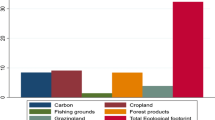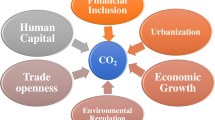Abstract
This study uses information from the input–output tables 2008, national accounts, household survey, and environmental pollutant emissions to elaborate an environmentally extended social accounting matrix for Chile. A linear multisector model is then generated in order to determine the effects that a sectoral shock on demand would have on economic development. The results show the typical economic trade-offs, concluding that it is necessary to consider economic relationships in order to assess the full impact of a sector on economic activity, income distribution, and pollution. The sectors commerce, construction, and food industry strongly increase economic growth and employment and decrease inequality. Nonetheless, when also considering the environmental effects, no sectors can be identified that contribute systematically and significantly to all the areas of economic development.







Similar content being viewed by others
Notes
The following disaggregation was used in the CASEN 2009: Unskilled: no formal, incomplete basic, or complete basic education. Semi-skilled: incomplete high school, incomplete technical-professional high school, complete high school, or complete technical high school education. Skilled: incomplete technical or university or complete technical or university education. The same disaggregation was used for the other subsectors.
Given the lack of information for 2008.
The symbol \( ^{\prime } \) denotes matrix transposition.
Thus, the total effects on the environmental accounts are greater than those estimated with an Input–Output model.
The technical coefficient of the capture of resources is not used in this paper due to the lack of data for Chile.
The results are exemplified using an increment in the demand of 1,000 million pesos of production; the same methodology is used for a decline of the demand in 1,000 million pesos of production.
This value includes an increment of 1,000 million pesos due to the increase in the final demand of the aquaculture industry sector.
The number of jobs per activity was obtained from the CASEN 2009. In the case of public and private health and education, we use the sectoral participation in the GDP to disaggregate the values in public and private.
References
Alarcón, J., Van Heemst, J., & de Jong, N. (2000). Extending the SAM with social and environmental indicators: An application to Bolivia. Economic Systems Research, 12(4), 473–496.
Bartelmus, P., Stahmer, C., & Van Tongeren, J. (1993). Integrated environmental and economic accounting—A framework for an SNA satellite system. In E. Lutz (Ed.), Toward improved accounting for the environment. Washington, DC: The World Bank.
Batey, P. W. J., Madden, M., & Weeks, M. J. (1987). Household income and expenditure in extended input-output models: A comparative theoretical and empirical analysis. Journal of Regional Science, 27(3), 341–356.
Batey, P. W. J., & Weeks, M. J. (1987). An extended input-output model incorporating employed, unemployed, and in-migrant households. Papers of the Regional Science Association, 62, 93–115.
Cantallopts, J., Jorratt, M., & Scherman, D. (2007). Equidad Tributaria en Chile: Un Nuevo Modelo para Evaluar Alternativas de Reforma, mimeo.
Cella, G. (1984). The input–output measurement of interindustry linkages. Oxford Bulletin of Economics and Statistics, 46, 73–84.
Cockburn, J. (2001). Trade liberalisation and poverty in Nepal: A computable general equilibrium micro simulation analysis. Discussion paper 01-18, CREFA, Université Laval.
Ghosh, A. (1958). Input-output approach to an allocative system. Economica, 25, 58–64.
González, A., Matus, G., & González, G. (2008). Efecto de las políticas económicas en los recursos naturales y el medio ambiente en México. Agrociencia, 42(7), 847–855.
Hartono, D., & Resosudarmo, B. (2008). The economy-wide impact of controlling energy consumption in Indonesia: An analysis using a social accounting matrix framework. Department of Economics, University of Indonesia. Indonesian Project, Economics Division, Research School of Pacific and Asian Studies, The Australian National University, Canberra, ACT 0200, Australia.
James, J., & Khan, H. A. (1993). The employment effects of an income redistribution in developing countries. World Development, 21(5), 817–827.
Keuning, S., van Heemst, J., & Alarcón, J. (1991). The social accounting framework for development, Averbury, England. Washington, Oxford: Policies, World Bank and Oxford University Press.
Kim, K. (2011). Ex-ante evaluation of a targeted job program: Hypothetical integration in a social accounting matrix of South Africa. Levy Economics Institute of Bard College, Blithewood, Annandale-on-Hudson, NY 12504, United States.
Lenzen, M., & Schaffer, R. (2004). Environmental and social accounting for Brazil. Environmental & Resource Economics, 27, 201–226.
Leontief, W. (1941). The structure of the American Economy, 1919–1929 (1st ed.). New York: Oxford University Press. (2nd edn., 1951).
Manresa, A., & Sancho, F. (2004). Energy intensities and CO2 emissions in Catalonia: A SAM analysis. Journal of Employment, Environment and the Workforce, 1(1), 91–106.
Miller, R. E., & Blair, P. D. (2009). Input-output analysis: Foundations and extensions (2nd ed.). Cambridge: Cambridge University Press.
Miyazawa, K. (1976). Input-output analysis and the structure of income distribution. Berlin: Springer.
Partridge, M., & Rickman, D. (2010). Computable general equilibrium (CGE) modelling for regional economic development analysis. Regional Studies, 44(10), 1311–1328.
Paukert, F., Skolka, J., & Maton, J. (1976). Redistribution of income patterns, consumption, and employment. In K. R. Polenske & J. V. Skolka (Eds.), Advances in input-output analysis. Cambridge, MA: Ballinger Publishing Co.
Pieters, J. (2010). Growth and inequality in India: Analysis of an extended social accounting matrix. World Development, 38(3), 270–281.
Polenske, K. R. (1989). Historical and New International Perspectives on Input-output Accounts. In R. E. Miller, K. R. Polenske, & A. Z. Rose (Eds.), Frontiers of input-output analysis. NewYork: Oxford University Press.
Pyatt, G. (1988). A SAM approach to modelling. Journal of Policy Modelling, 10(3), 327–352.
Pyatt, G., & Round, J. (1977). Social accounting matrices for development planning. Review of Income and Wealth, 23(4), 339–364.
Pyatt, G., & Round, J. (1979). Accounting an fixed price multipliers in a social accounting matrix framework. Economic Journal, 89, 850–873.
Resosudarmo, B. P., & Thorbecke, E. (1996). The impact of environmental policies on household incomes for different socio-economic classes: The case of air pollutants in Indonesia. Ecological Economics, 17(2), 83–94.
Robilliard, A.-S., Bourguignon, F., & Robinson, S. (2001). Crisis and income distribution: A micro-macro model for Indonesia, mimeo. The World Bank, DIAL, and IFPRI.
Robinson, S. (1986). Multisectoral models of developing countries: A survey. Working paper no. 401, Department of Agricultural and Resource Economics, University of California, Berkeley.
Rodríguez, C. (2004). Sistema híbrido para el análisis de las relaciones entre el medioambiente, la economía y la sociedad: Aplicación para año 2000, al recurso agua y las emisiones a la atmósfera en España. Tesis doctoral. Universidad de Sevilla.
Rodríguez, C., Cardente, M., & Llanes, G. (2005). Estimación y actualización anual de matrices de contabilidad social: Aplicación a la economía española para los años 1995 y 1998. Estadística Española, 47(159), 353–416.
Santos, S. (2004). Portuguese net borrowing and the government budget balance A SAM approach. Department of Economics, Institute of Economics and Business Administration, Technical University of Lisbon, Rua Miguel Lupi, 20, 1249-078 Lisboa, Portugal.
Schuschny, A. (2005). Tópicos sobre el Modelo de Insumo-Producto: Teoría y Aplicaciones. Serie Estudios Estadísticos y Prospectivos, CEPAL (37).
Stone, R. (1963). Input-Output Relationships. London: Department of Applied Economics, University of Cambridge.
Tarp, F., Roland-Holst, D., & Rand, J. (2003). Economic structure and development in an emergent Asian economy: Evidence from a social accounting matrix for Vietnam. Journal of Asian Economics, 13(6), 847–871.
Vos, R., & Jong, N. (2003). Trade liberalization and poverty in Ecuador: A CGE macromicrosimulation analysis. Economic Systems Research, 15, 211–232.
Weale, M. (1997). Environmental statistics and the national accounts. In P. Dasgupta & K.-G. Mäler (Eds.), The environment and emerging development issues. Oxford: Clarendon Press.
Xie, J. (2000). An Environmentally Extended Social Accounting Matrix. Environmental & Resource Economics, 16(4), 391–406.
Acknowledgments
The authors are grateful to the National Fund for Scientific and Technological Development (Fondecyt) (initiation project no. 11110007) for the finance it provided for this research.
Author information
Authors and Affiliations
Corresponding author
Rights and permissions
About this article
Cite this article
Gallardo, A., Mardones, C. Environmentally extended social accounting matrix for Chile. Environ Dev Sustain 15, 1099–1127 (2013). https://doi.org/10.1007/s10668-012-9430-0
Received:
Accepted:
Published:
Issue Date:
DOI: https://doi.org/10.1007/s10668-012-9430-0




